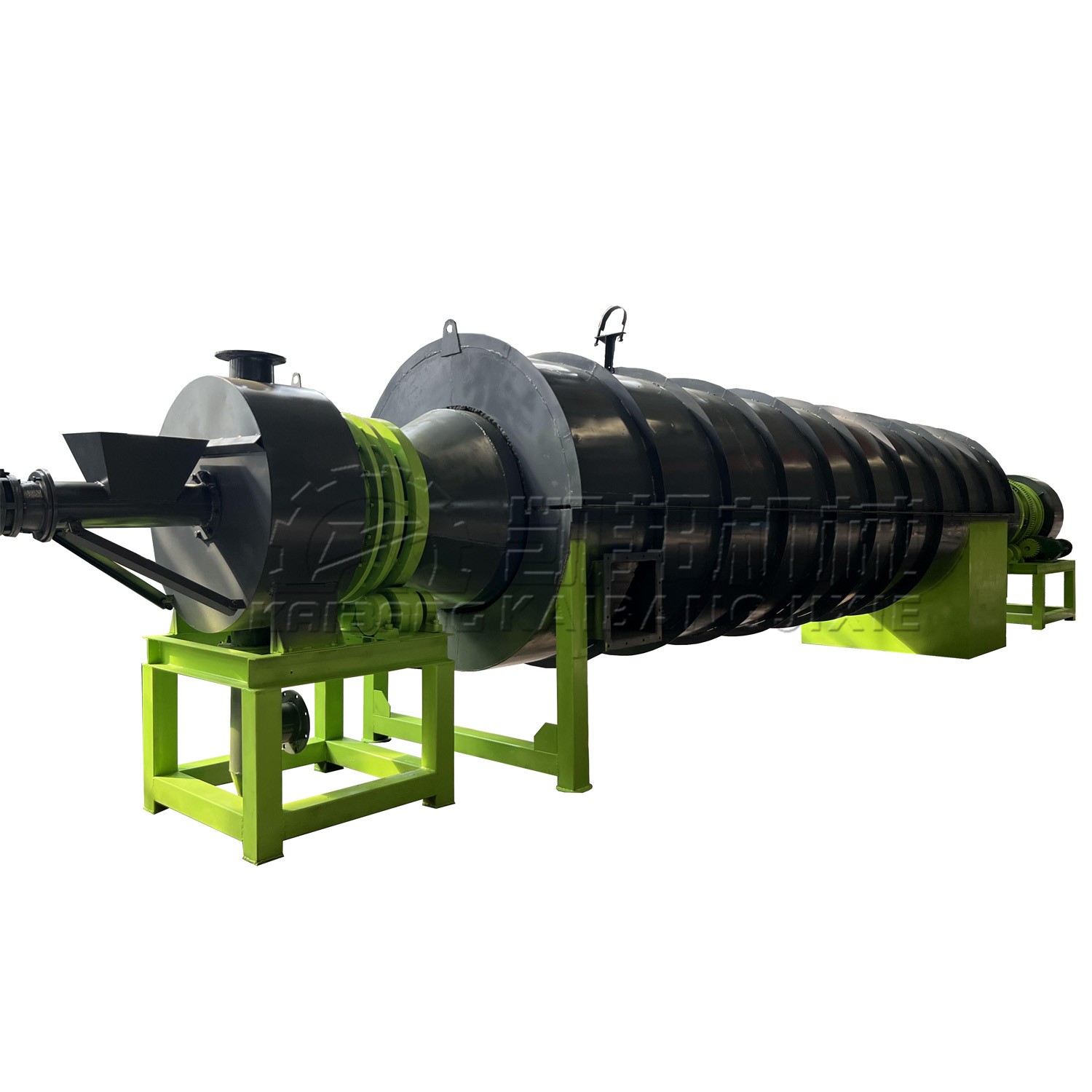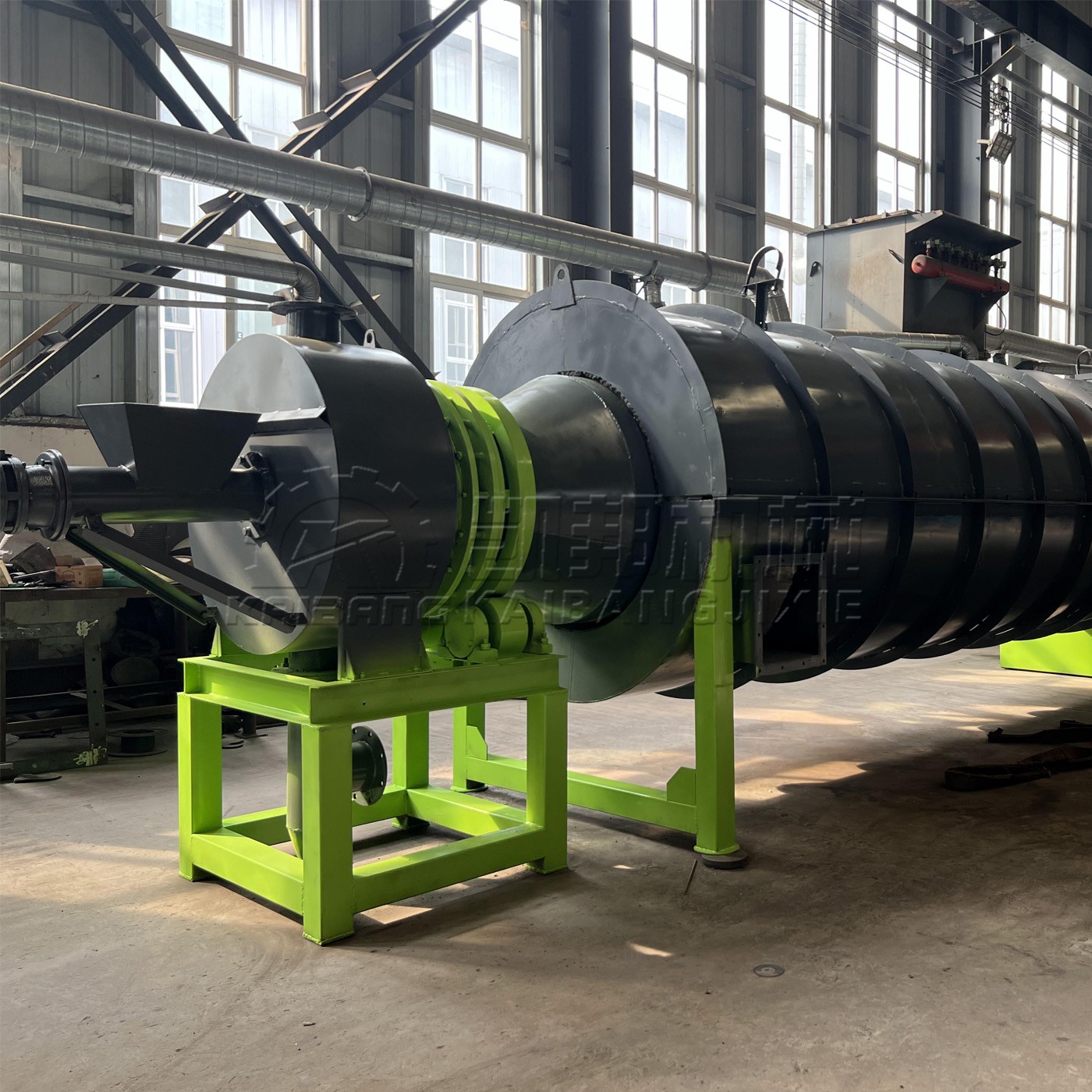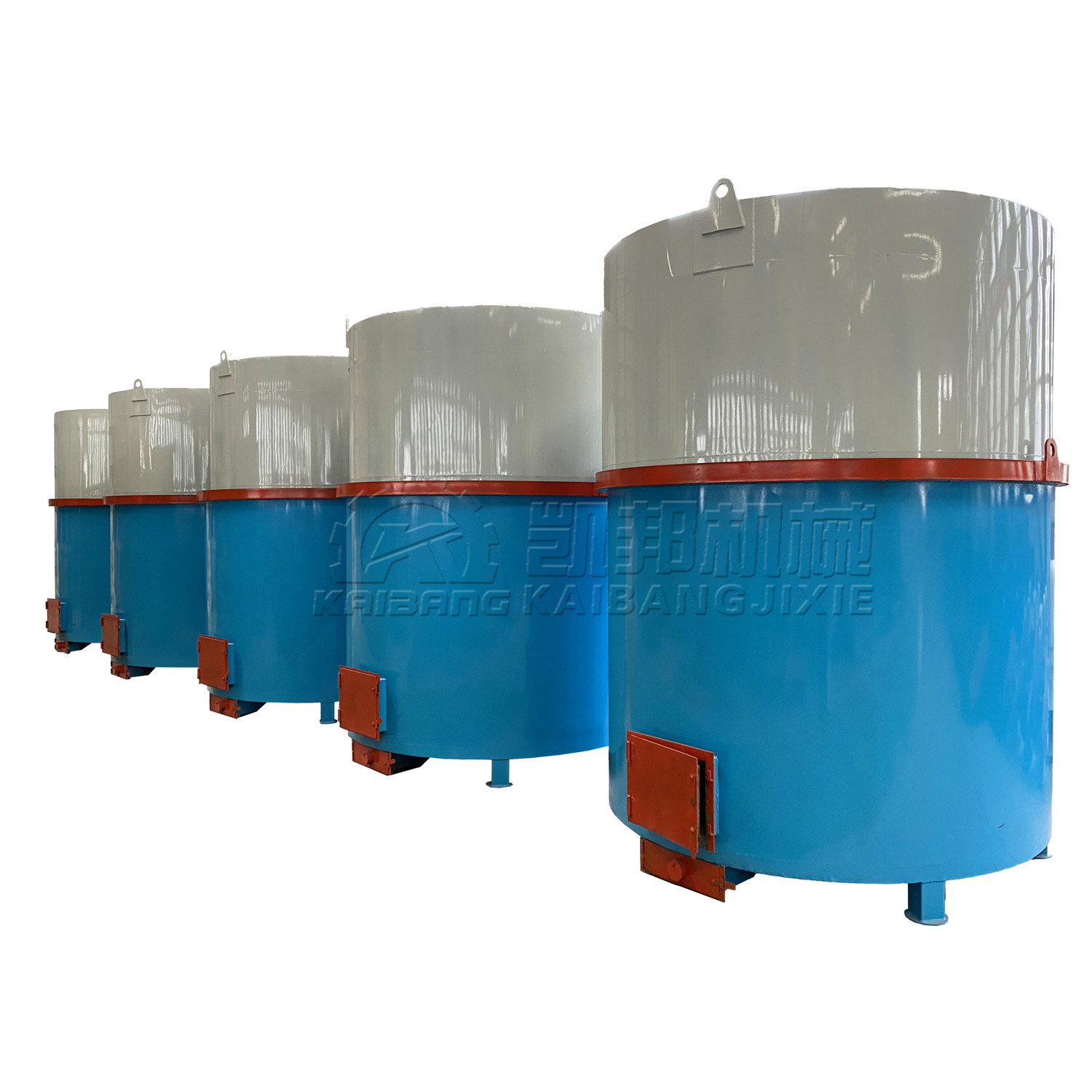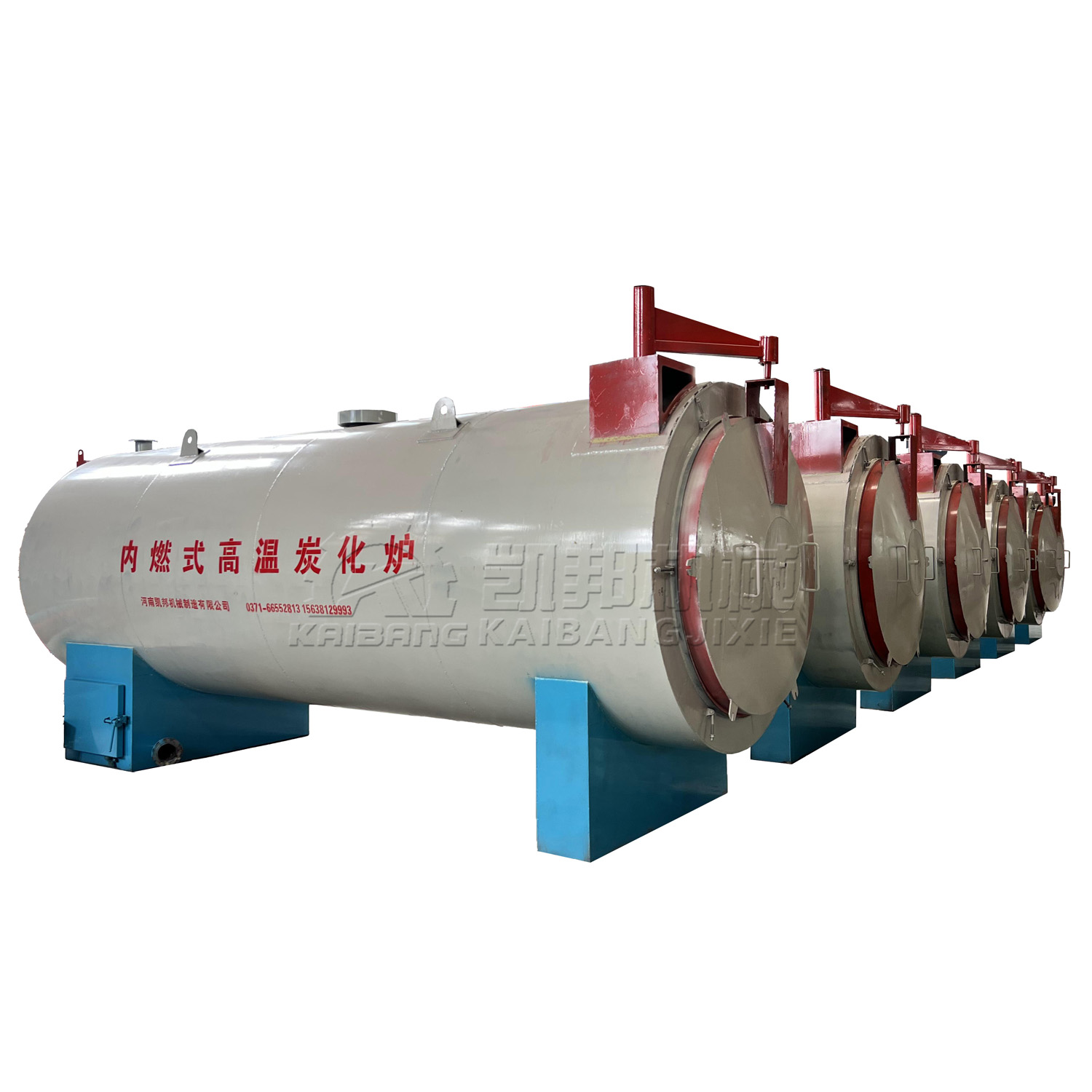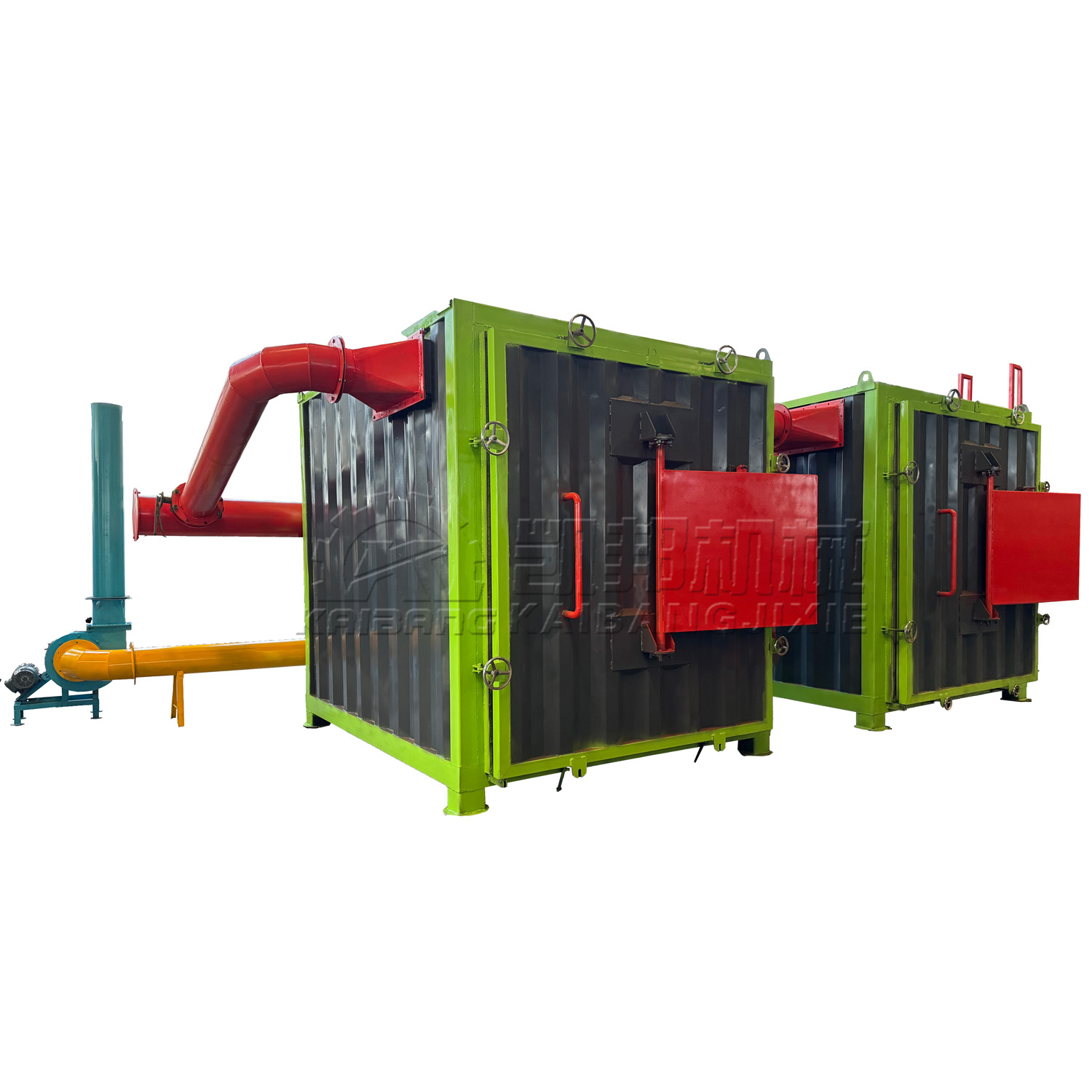Continuous Carbonization Furnace
Brand: KAIBANG
Capacity: 300-2500kg/h (Depending on material type)
Inner furnace temperature: 350-850°C
Carbonized pipeline temperature: 500-750 °C
Working continuously: 24h
Warranty: 1 years

The continuous carbonization machine is an efficient and energy-saving carbonization equipment, consisting of core components such as a flue gas purification device, a variable-frequency induced draft fan, a high-temperature burner, a carbonization main unit, a feeding machine, and a discharging machine. It adopts an innovative stainless steel rotary double-cylinder structure, where the outer cylinder is responsible for high-temperature carbonization of raw materials, while the inner cylinder dries and preheats them. This design not only enhances the strength of the cylinder but also significantly improves the thermal energy utilization rate, making the carbonization process more efficient and environmentally friendly.
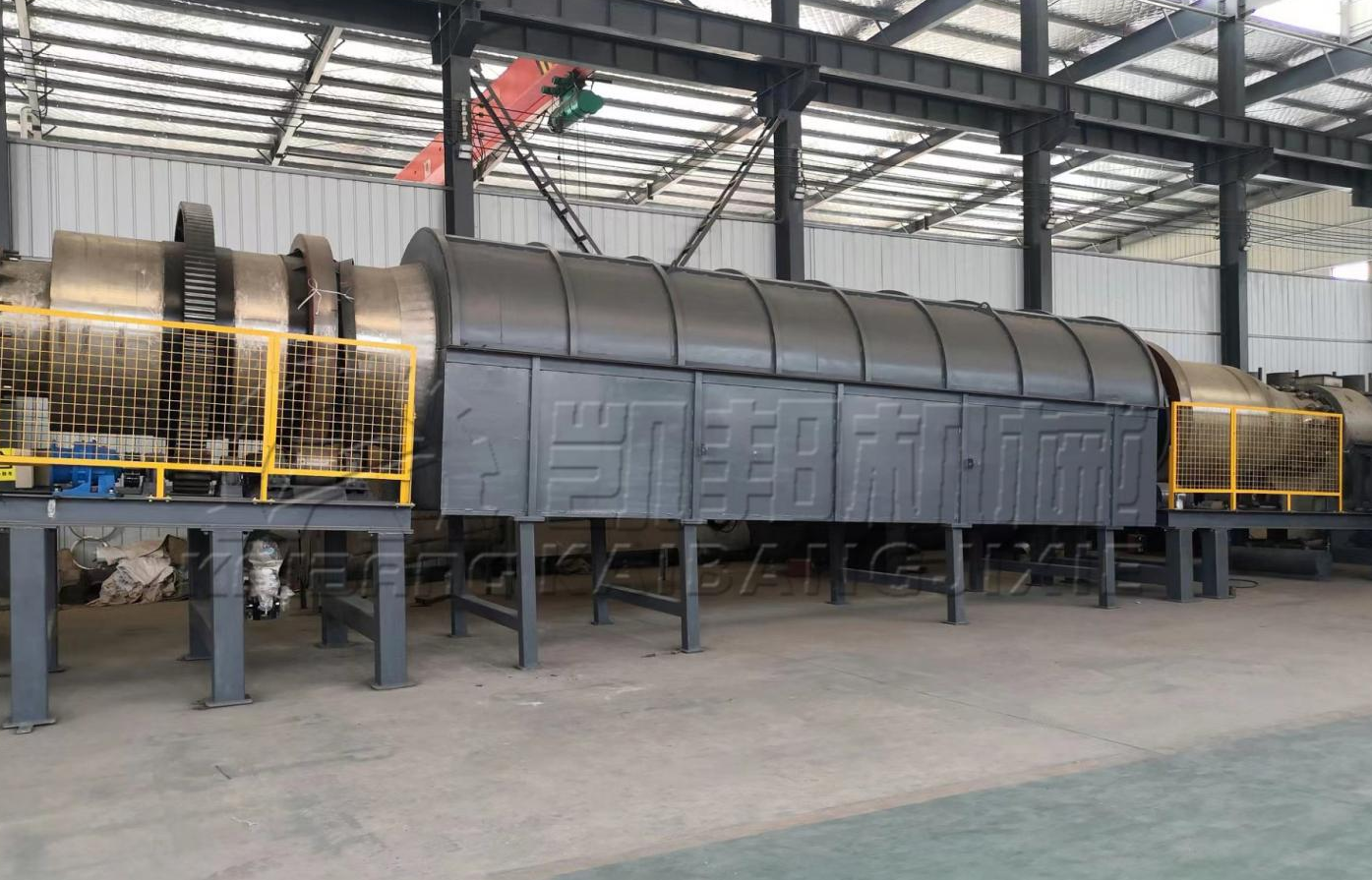
The dry distillation carbonization process is one of the core technologies of this equipment, which utilizes the flue gases (such as methane, carbon monoxide, hydrogen, etc.) generated during the carbonization pyrolysis process for circular heating. The carbonization raw materials enter the rotating cylinder from the furnace tail and gradually move towards the furnace head as the cylinder rotates. During the rotation, the raw materials directly contact the hot flue gases entering from the furnace head, achieving drying and carbonization. The well-carbonized raw materials flow out from the discharging outlet after cooling, and the entire process requires no shutdown for cooling, enabling 24-hour continuous carbonization, which greatly improves production efficiency and energy utilization.
The continuous carbonization machine has a wide range of applications and can carbonize various materials, including wheat straw, bamboo and wood shavings, branches, sawdust, coconut shells, bark, corn cobs, sludge, rice husks, and other raw materials. This diversified raw material adaptability makes the continuous carbonization machine have broad application prospects in agriculture, forestry, and environmental protection.

The carbonization furnace is internally equipped with ingenious baffle plates. Once raw materials enter the main carbonization chamber, they are guided by these baffle plates to move horizontally as the chamber rotates. Slowly advancing from the feed inlet towards the carbon outlet, the raw materials gradually undergo the carbonization process. To guarantee the smooth progression of this process, both the feed inlet and the carbon outlet are fitted with airlocks, effectively isolating air. Meanwhile, these components work in concert with the induced draft fan of the main carbonization chamber to maintain an oxygen-depleted environment during continuous feeding and carbon discharging.
In a Continuous carbonization furnace, once the material has completed carbonization, the carbon blocks naturally fall into the screw conveyor at the carbon outlet. This conveyor is equipped with a water-cooled heat exchange system, which rapidly cools the carbon blocks as they pass through, reducing their temperature from a high state to approximately 40°C. This ensures smooth carbon discharge during the continuous operation of the equipment.
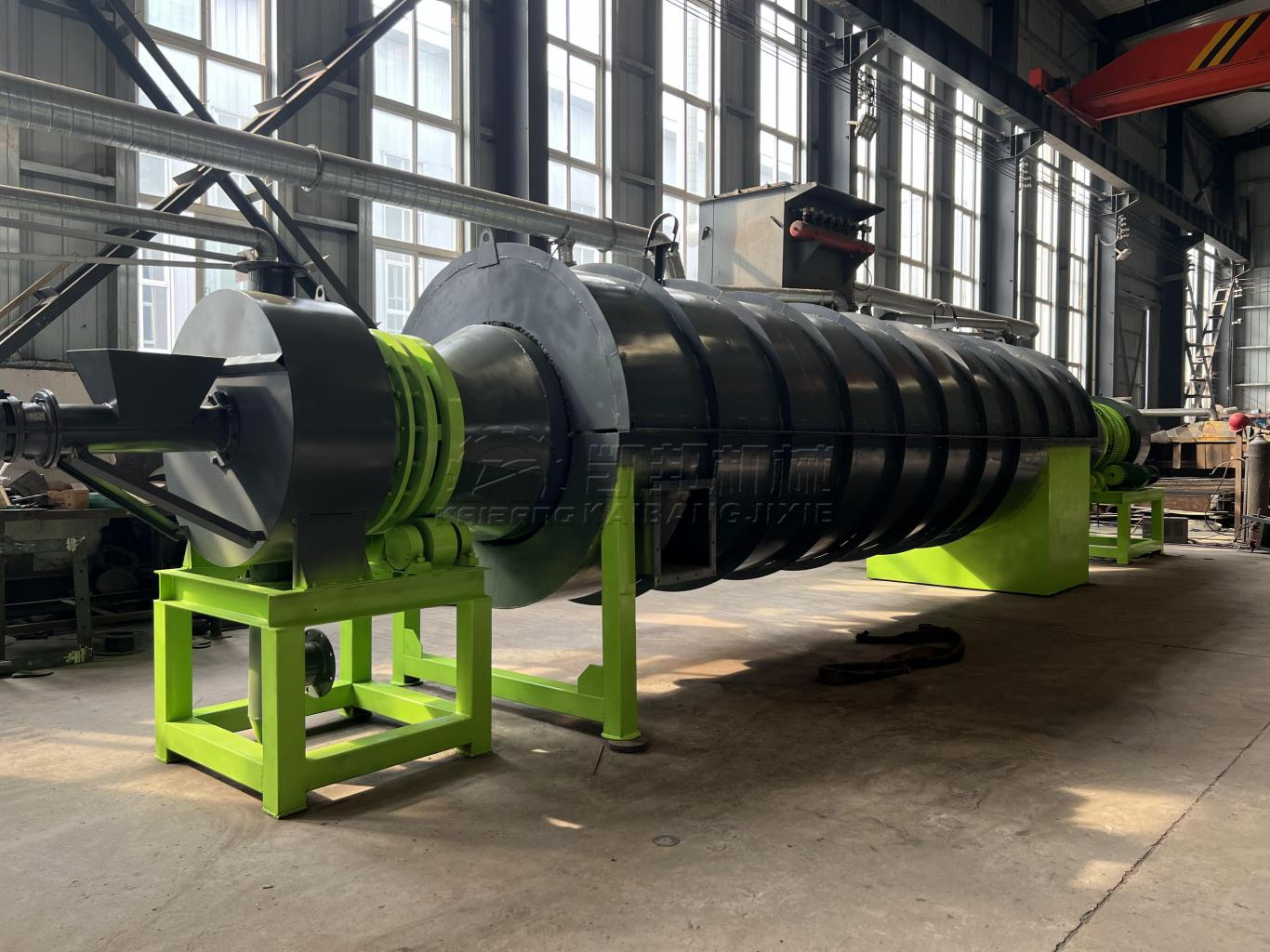

The continuous carbonization furnace can be efficiently preheated using liquefied petroleum gas or natural gas in the initial stage. As the furnace temperature gradually increases to the appropriate level required for material carbonization (approximately 400°C), the screw feeder precisely delivers the materials to be carbonized into the interior of the furnace. Upon entering the high-temperature zone, the materials rapidly undergo pyrolysis, producing combustible gases. These gases are immediately recovered by a high-pressure fan and directed into the return smoke duct. Due to the short and direct design of the return smoke duct, the combustible gases hardly dissipate any heat within it. Simultaneously, liquids such as tar and wood vinegar remain in their liquid state, as they have not reached the physical conditions for condensation, and are directly conveyed to the burner for combustion and utilization. The equipment is equipped with an auxiliary fan, which can directly transport tar, wood vinegar, and other liquids to the burner for combustion. Since wood tar contains combustible components such as hydrogen and methane, the high-temperature characteristics of these gases further elevate the carbonization temperature of the equipment. This design not only fully exploits the energy value of tar and wood vinegar by enabling their secondary pyrolysis and combustion but also effectively mitigates the potential secondary pollution issues arising from the emission of wood tar and wood vinegar.


The continuous carbonization furnace comprises components such as a drying furnace, a main carbonization furnace, a condenser, and a cooling tower. The main carbonization furnace itself is made up of parts like the main drum, casing, and combustion chamber.
This continuous carbonization furnace adopts the principle of gasification carbonization, incorporating smokeless and environmentally friendly carbonization technology, forming a comprehensive equipment system. It primarily consists of four key sections: the gasification system (encompassing the gasifier, spray tower, and dust collector), the purification system (which includes the spray tower, oil-water separator, and filter), the carbonization system (comprising the carbonization main unit, screw feeder, screw discharger, cooling discharge conveyor, finished product cooling silo, and material conveyor), and the control system (consisting of the control cabinet). The entire carbonization process is automated, greatly enhancing production efficiency and environmental performance.
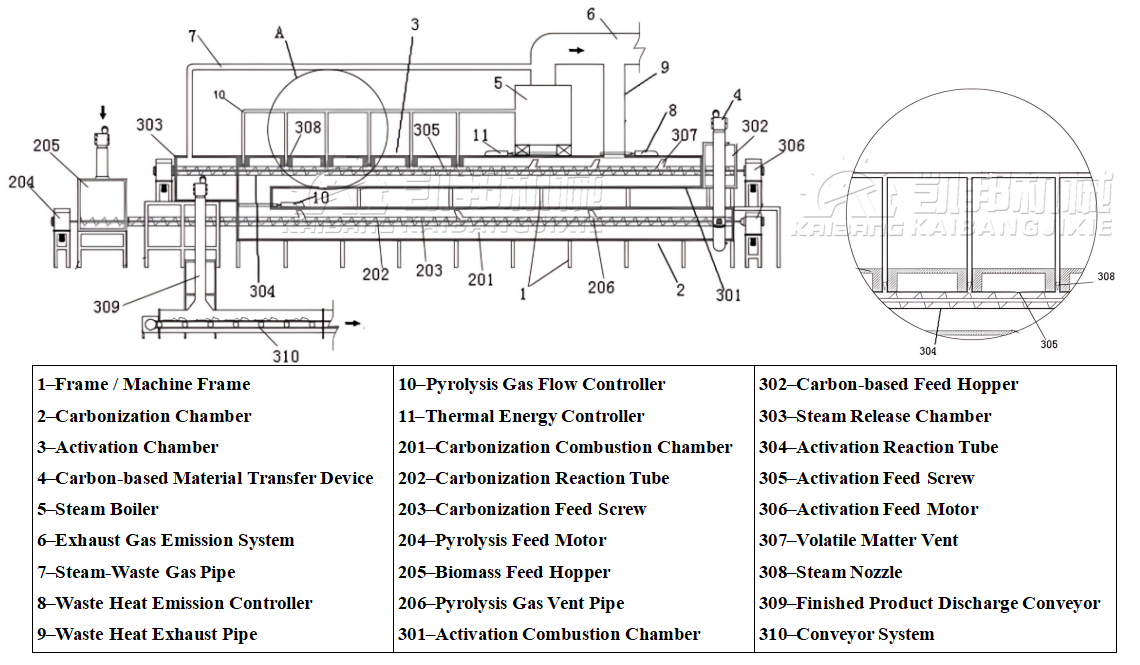

Features
1.Dynamic Sealing and Continuous High-Efficiency Production
The continuous carbonization furnace adopts a unique design at both the feed inlet and carbon outlet, ensuring tight sealing during operation. This design allows raw materials to enter the carbonization furnace continuously and stably, while the carbonized material is discharged continuously through the carbon outlet, realizing true continuous production. The furnace can process 20 to 120 tons of raw materials per day, greatly improving production efficiency and meeting the needs of large-scale production.
2.Stainless Steel 310S Material
The main combustion zone of the continuous carbonization furnace is made of high-quality stainless steel 310S, which has excellent high-temperature resistance. This allows the main combustion zone to operate stably under extreme high-temperature conditions, with a maximum working temperature reaching an astonishing 1500°C. This fully meets the stringent requirements for high-temperature environments during carbonization, ensuring efficient and stable operation of the carbonization furnace.
3.The double-cylinder structure features two heating methods: internal combustion and external combustion.
The main cylinder of the continuous carbonization furnace innovatively adopts a double-layer structure design, with the inner layer used for drying and the outer layer focused on the carbonization process. This design not only greatly saves floor space, reducing space requirements by almost half compared to traditional single-layer structures, but also effectively reduces the contact area between the cylinder and the external environment. Due to the reduced contact area, heat loss is also reduced, significantly improving the utilization rate of thermal energy. This double-layer structure design not only makes the carbonization furnace more compact and efficient, but also further enhances its energy-saving and environmentally friendly performance.
4.Triple Safety Guarantee
The main furnace of the continuous carbonization furnace is equipped with an explosion-proof plate design. This safety device can quickly and directionally relieve pressure when abnormal pressure occurs inside the furnace, effectively preventing safety accidents caused by excessive pressure and ensuring safe and stable operation of the equipment.
In addition, sensors are installed at multiple key positions of the carbonization furnace. These sensors act like the "nerve endings" of the equipment, capable of monitoring various status parameters inside the furnace in real time. Once an abnormal state occurs, the sensors will immediately feed back information to the control system, allowing operators to quickly grasp the equipment status and take corresponding measures.
Moreover, the equipment incorporates Internet of Things technology to realize remote monitoring functions. Operators can manage the equipment in real time through remote terminals, monitor the operating status of the equipment anytime and anywhere, and discover and deal with potential problems in a timely manner. This intelligent management method not only improves the operating efficiency of the equipment, but also greatly reduces the cost and risk of manual management.
5.Energy-Saving Production and Recycling of Combustible Gas
In most cases, the continuous carbonization furnace does not require additional fuel for heating except during the preheating stage. The heat demand for carbonization can be met solely through the recycling and utilization of the combustible gas produced during material carbonization.
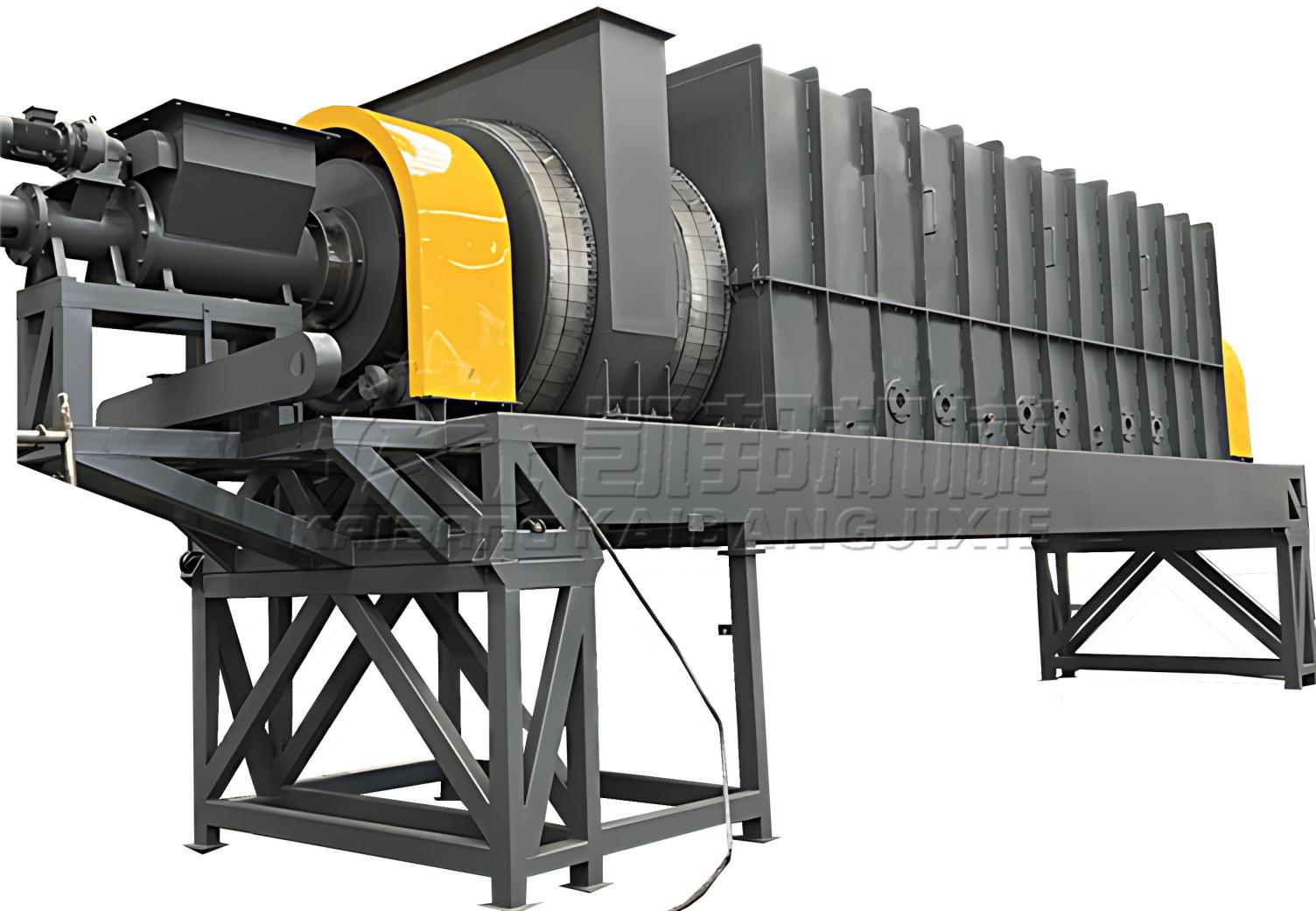
Advantages
1.The continuous carbonization furnace is characterized by a high level of automation, allowing for continuous operation.
2.The smoke recovery, incineration, and dust removal systems ensure that emissions comply with standards, thereby achieving cost savings, energy conservation, and emission reduction.
3.The finished charcoal is automatically cooled in the circulating water system, conserving considerable water resources.
4.The continuous carbonization machine incorporates an automatic feeding mechanism, which is not constrained by distance, reducing manual labor intensity and enhancing carbonization efficiency.
5.The dust removal system is equipped with both pulse dust collectors and centrifugal separators, significantly improving the cleanliness of the working environment.

The continuous carbonization furnace is capable of carbonizing a diverse range of raw materials, including biomass, sludge, and waste, among others. Raw materials with a size smaller than 2 centimeters and a moisture content of less than 15% can undergo direct carbonization. For materials larger than 2 centimeters, a crusher is required to reduce their size to below 2 centimeters prior to carbonization. If the moisture content exceeds 15%, the use of a drying oven in conjunction with the carbonization process is necessary.
When it comes to biomass, the furnace can process rice husk, straw, coconut shells, palm shells, bamboo, wood chips, sugarcane residue, distiller's grains, olive shells, coffee shells, fruit shells, hazelnut shells, sawdust, oak wood, jute stalks, peanut shells, sunflower stalks, peach pits, and various other materials.
Regarding sludge, the furnace is capable of handling municipal sludge, river sludge, and industrial sludge.
As for waste, it can process urban household waste.
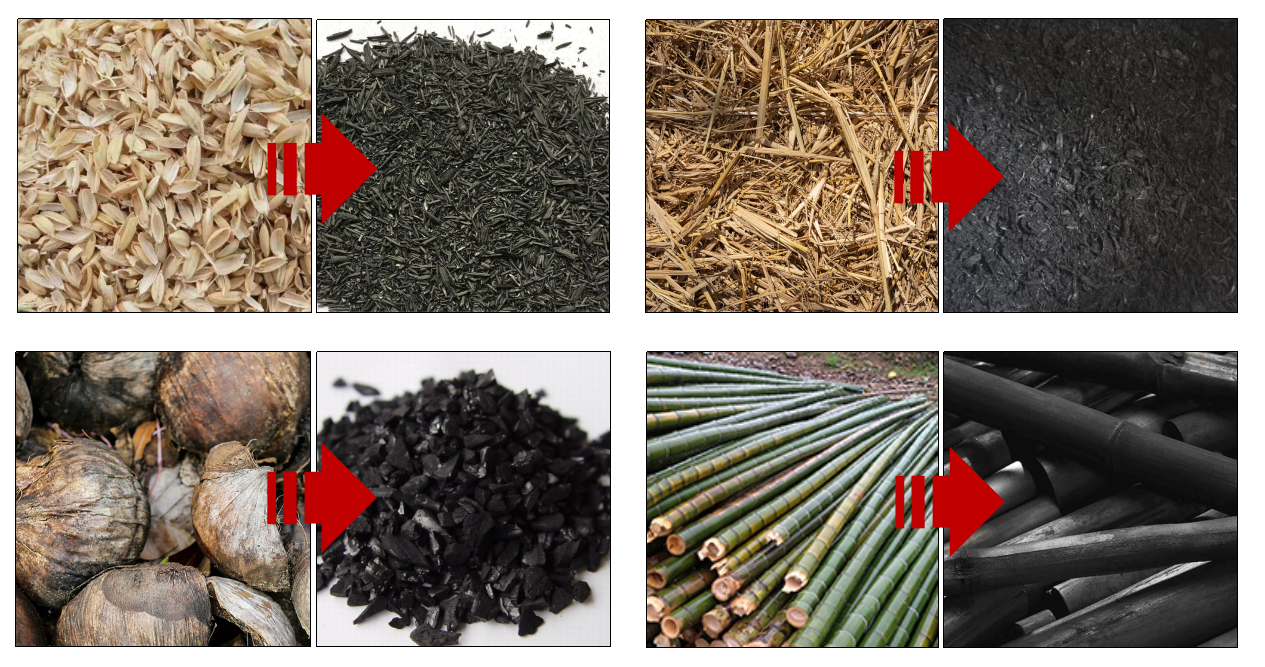

Biomass carbonization:The main product of biomass carbonization is charcoal (in the form of particles or powder). Biomass charcoal can be used to process charcoal-based fertilizers, barbecue charcoal sticks, hookah charcoal, activated carbon, and other products.
Sludge carbonization:The primary objectives of sludge carbonization are reduction in volume and harmless treatment. Additionally, carbonized sludge possesses a certain calorific value and can be utilized for brick manufacturing, processing of slow-release fertilizers, and production of roadbed materials.
Waste carbonization:Carbonization of household waste aims primarily at reduction in volume, harmless treatment, and resource recovery. Household waste, clothing scraps, electronic waste, and other types of waste can all be processed through carbonization. The carbonized waste can then be used as fuel.

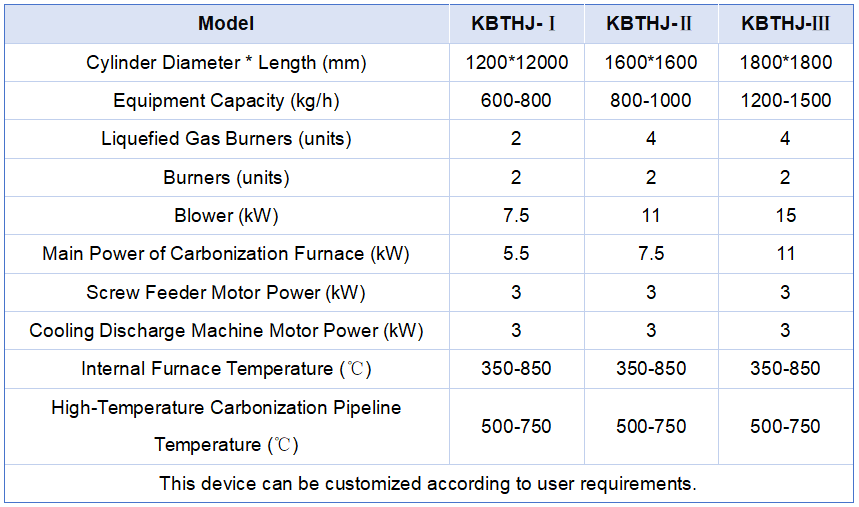
<Note: With continuous technological upgrades, all parameters are provided for reference only. In case of any modifications, please refer to the actual product for accuracy.>

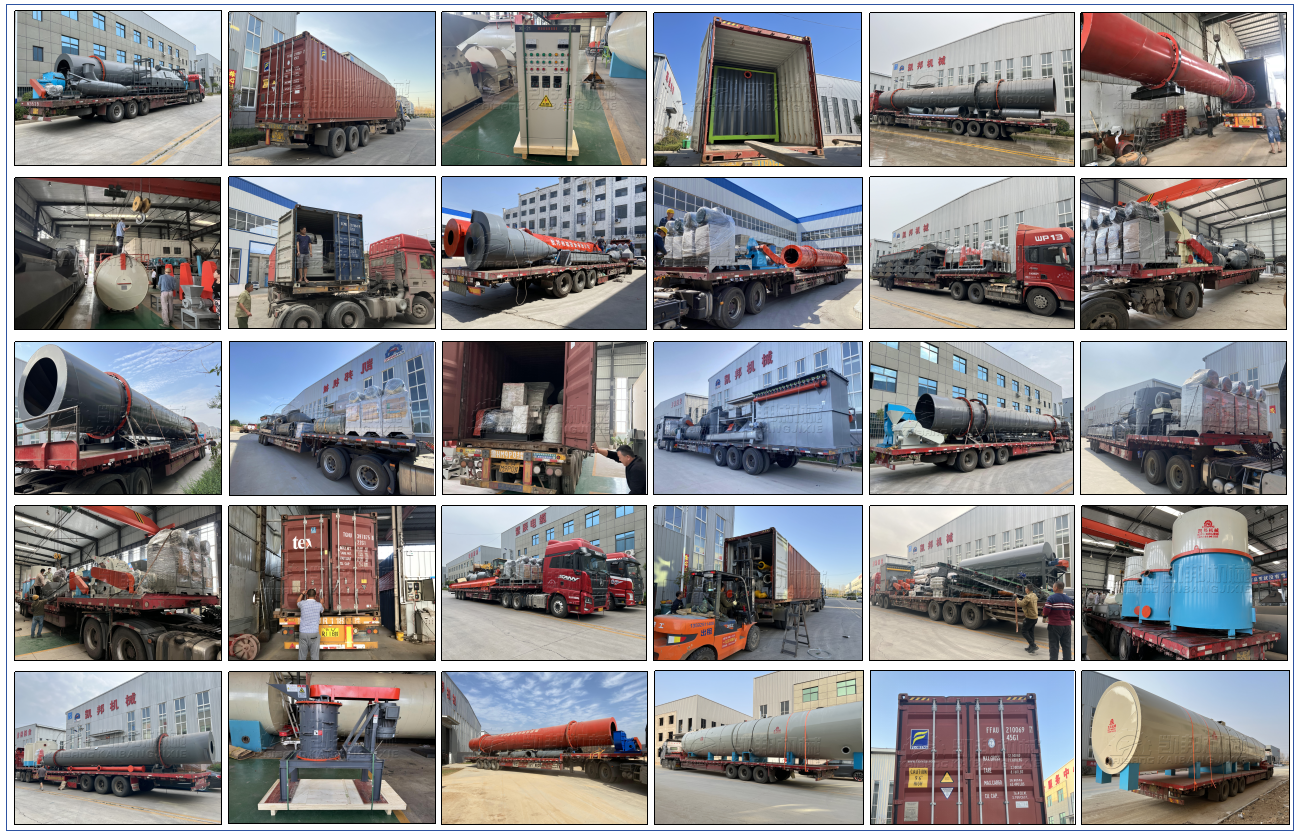

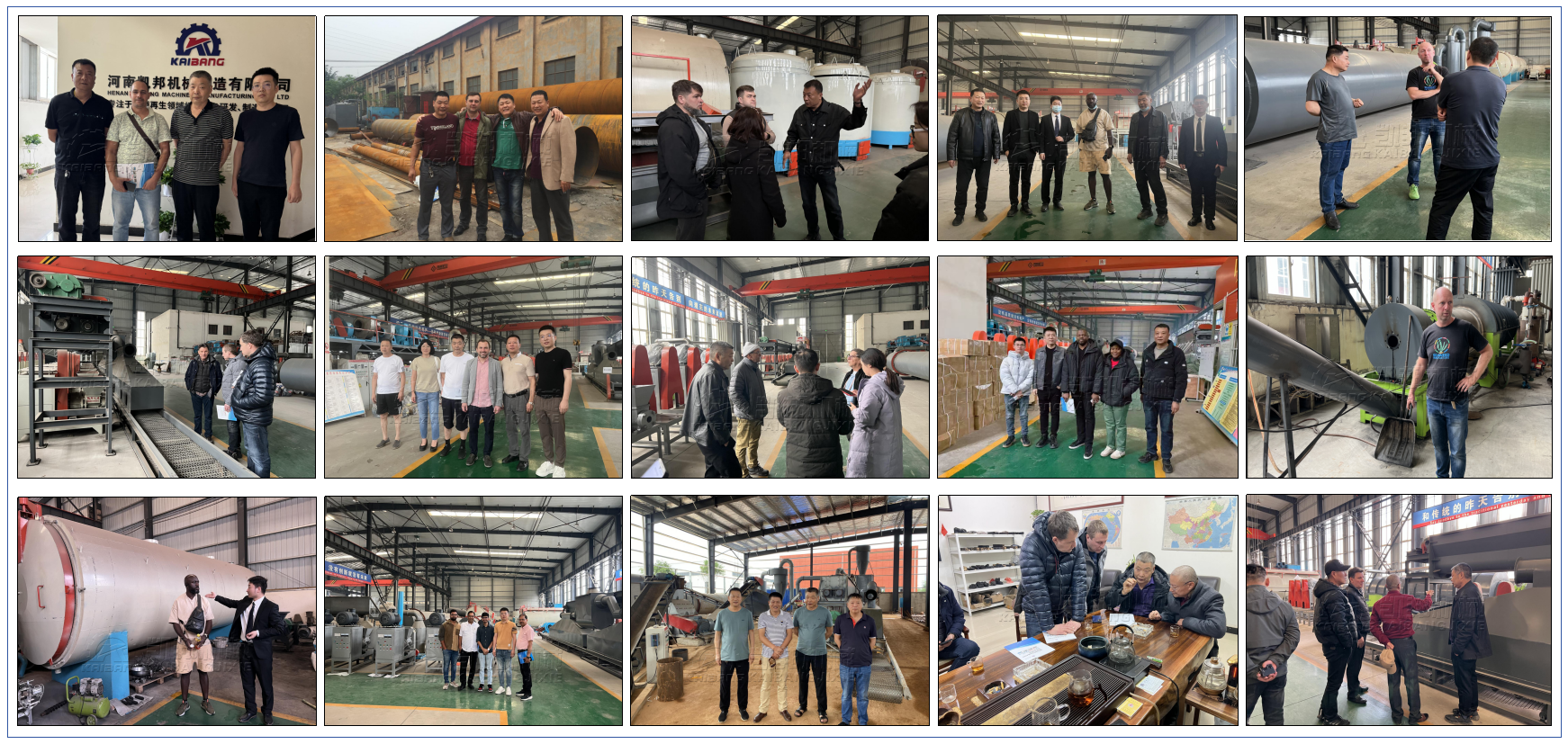

Henan Kaibang Machinery Manufacturing Co., Ltd. mainly produces: crushing equipment, drying equipment, forming equipment, pyrolysis reactor equipment, environmental protection equipment, and other complete production line equipment. The company's equipment production, casting and forming, mechanical processing, physical and chemical treatment, to assembly into machines, is fully tracked and inspected by quality testing engineers throughout the process to ensure that users receive high-quality, reliable equipment.
The company has been working hard to build the Kaibang brand for decades, always pursuing excellence, with high-quality staff, strict quality assurance system and perfect after-sales service. We warmly welcome domestic and overseas customers to visit our company for on-site inspection and guidance
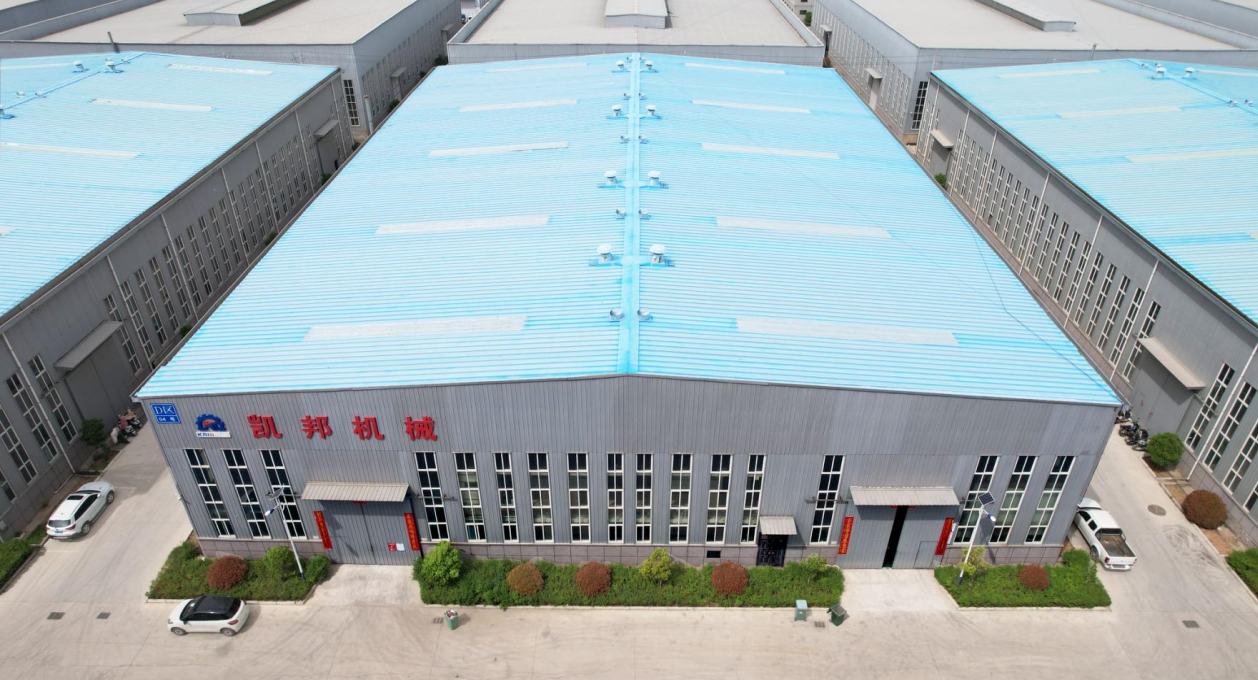
INQUIRY
CATEGORIES
LATEST NEWS
CONTACT US
Contact: info@kaibangmachinery.com
Phone: 15638129993
E-mail: +86 15638129993
Whatsapp:86 15638129993
Add: 800 meters east of the intersection of Chuangye Avenue and E23 in Gongyi Industrial Agglomeration Zone, Zhengzhou City, Henan Province, north of the road
